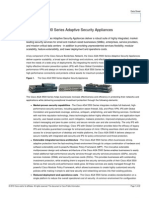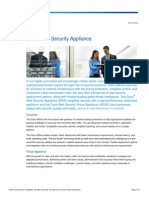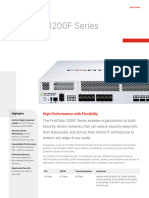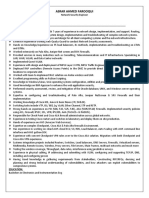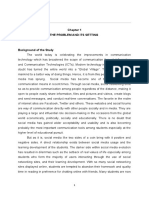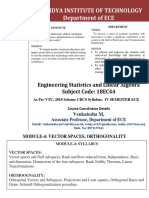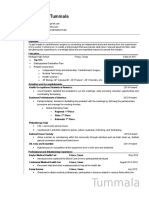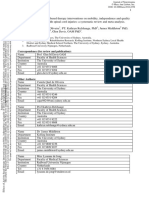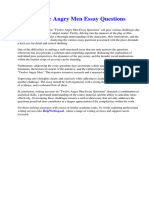ASA 5585X in DataCenter
ASA 5585X in DataCenter
Uploaded by
Ngo Trung KienCopyright:
Available Formats
ASA 5585X in DataCenter
ASA 5585X in DataCenter
Uploaded by
Ngo Trung KienCopyright
Available Formats
Share this document
Did you find this document useful?
Is this content inappropriate?
Copyright:
Available Formats
ASA 5585X in DataCenter
ASA 5585X in DataCenter
Uploaded by
Ngo Trung KienCopyright:
Available Formats
Design Guide
Cisco ASA 5585-X in the Data Center
Cisco ASA 5500 Series Adaptive Security Appliances combine advanced stateful firewall and VPN concentrator capabilities in one device. The appliances include many advanced features, such as multiple security contexts (similar to virtualized firewalls), transparent (Layer 2) firewall or routed (Layer 3) firewall operation, advanced inspection engines, intrusion prevention, IPsec and WebVPN support, and more. Data Center
In this section we will discuss the business needs associated with deploying firewalls in the Data Center, what the requirements for the proposed solution. An overview of the various ASA technologies that are incorporated in the solution is also discussed.
Business Need: Deploying Firewalls in the Data Center
The data center is more important to the enterprise than ever before. An increase in the concentration of data services in data centers has led to a corresponding increase in the need for high performance and scalable network security. To address this need, Cisco introduced the ASA 5580, an appliance meeting the 5 Gbps and 10 Gbps needs of campuses and data centers. Cisco has now broadened the ASA portfolio further: The next-generation ASA 5585-X appliance is expanding the performance envelope of the ASA 5500 Series to offer 2 Gbps to 20 Gbps of realworld HTTP traffic and 35 Gbps of large packet traffic. The Cisco ASA 5585-X supports up to 350,000 connections per second and a total of up to two million simultaneous connections initially, and is slated to support up to eight million simultaneous connections in a later release. The advent of Web 2.0 applications has brought about a dramatic increase in new device types and the extensive use of complex content, which is straining existing security infrastructures. Today's security systems are often unable to meet the high transaction rates or depth of security policies necessary in these environments. As a result, information technology staffs often struggle to provide basic security services and to keep up with the magnitude of security events generated by these systems for necessary monitoring, auditing, and compliance purposes. Cisco ASA 5585-X appliances are designed to protect the media-rich, highly transactional, and latency-sensitive applications at the enterprise data center. Providing market-leading throughput, the highest connection rates in the industry, large policy configurations, and very low latency, the ASA 5585-X is highly suitable for the security needs of organizations with the most demanding applications, such as voice, video, data backup, scientific or grid computing, and financial trading systems.
Solution Requirements
The Cisco ASA 5585-X appliance provides a flexible, cost-effective, and performance-based solution that allows users and administrators to establish security domains with different policies within the organization. Users need to be able to set appropriate policies for different VLANs. Data centers require stateful firewall security solutions to filter malicious traffic and protect data in the demilitarized zones (DMZ) and extranet server farms while delivering multi gigabit performance at the lowest possible cost. The Cisco ASA 5585-X appliance can be deployed in an Active/Active or Active/Standby topology and can make use of additional features such as interface redundancy for added resilience. Separate links are used also for the fault tolerance and state links.
2010 Cisco and/or its affiliates. All rights reserved. This document is Cisco Public Information.
Page 1 of 8
Design Guide
The Cisco ASA 5585-X appliance delivers multi gigabit security services for large enterprise, data center, and service provider networks. The appliance accommodates high-density copper and optical interfaces with scalability from Fast Ethernet to 10 Gigabit Ethernet, enabling unparalleled security and deployment flexibility. This high-density design enables security virtualization while retaining the physical segmentation desired in managed security and infrastructure consolidation applications.
Scope
This document provides information about design considerations and implementation guidelines when deploying firewall services in the data center using the Cisco ASA 5585-X appliance.
Cisco ASA Technical Concepts
Security Policy Firewalls protect internal networks from unauthorized access by users on an external network. The firewall can also protect internal networks from each other - for example, by keeping a human resources network separate from a user network. Cisco ASA appliances include many advanced features, such as multiple security contexts, transparent (Layer 2) firewall or routed (Layer 3) firewall operation, hundreds of interfaces, and more. When discussing networks connected to a firewall, the external network is in front of the firewall, and the internal network is protected and behind the firewall. A security policy determines the kind of traffic that is allowed to pass through the firewall to access another network, and will generally not allow any traffic to pass the firewall unless the security explicitly allows it to happen. Cisco Intrusion Prevention Services The Cisco Advanced Inspection and Prevention Security Services Processor (AIP SSP) combines inline intrusion prevention services with innovative technologies to improve accuracy. When deployed within Cisco ASA 5585-X appliances, the SSPs offer comprehensive protection of your IPv6 and IPv4 networks by collaborating with other network security resources, providing a proactive approach to protecting your network. The Cisco AIP SSP helps you stop threats with greater confidence through the use of:
Wide-ranging IPS capabilities: The Cisco AIP SSP delivers all the IPS capabilities available on Cisco IPS 4200 Series Sensors, and can be deployed inline in the traffic path or in promiscuous mode.
Global correlation: The Cisco AIP SSP provides real-time updates on the global threat environment beyond your perimeter by adding reputation analysis, reducing the window of threat exposure, and providing continuous feedback.
Comprehensive and timely attack protection: The Cisco AIP SSP delivers protection against tens of thousands of known exploits and millions more potential unknown exploit variants using specialized IPS detection engines and thousands of signatures.
Zero-day attack protection: Cisco anomaly detection learns the normal behavior on your network and alerts you when it sees anomalous activities in your network, helping to protect against new threats even before signatures are available.
When IPS is deployed to traffic flows within the ASA appliance, those flows will automatically inherit all redundancy capabilities of the appliance. High Availability Cisco ASA security appliances provide one of the most resilient and comprehensive high-availability solutions in the industry. With features such as sub-second failover and interface redundancy, customers can implement very advanced high-availability deployments, including full-mesh Active/Standby and Active/Active failover configurations.
2010 Cisco and/or its affiliates. All rights reserved. This document is Cisco Public Information.
Page 2 of 8
Design Guide
This provides customers with continued protection from network-based attacks and secures connectivity to meet todays business requirements. With Active/Active failover, both units can pass network traffic. This also lets you configure traffic sharing on your network. Active/Active failover is available only on units running in multiple context mode. With Active/Standby failover, a single unit passes traffic while the other unit waits in a standby state. Active/Standby failover is available on units running in either single or multiple context mode. Both failover configurations support stateful or stateless failover. The unit can fail if one of these events occurs:
The unit has a hardware failure or a power failure. The unit has a software failure. Too many monitored interfaces fail. The administrator has triggered a manual failure by using the CLI command no failure active
Even with stateful failover enabled, device-to-device failover may cause some service interruptions. Some examples are:
Incomplete TCP 3-way handshakes must be reinitiated. In Cisco ASA Software Release 8.3 and earlier, Open Shortest Path First (OSPF) routes are not replicated from the active to standby unit. Upon failover, OSPF adjacencies have to be reestablished and routes relearnt.
Most inspection engines states are not synchronized to the failover peer unit. Failover to the peer device loses the inspection engines states.
Active/Standby Failover Active/Standby failover lets you use a standby security appliance to take over the functions of a failed unit. When the active unit fails, it changes to the standby state while the standby unit changes to the active state. The unit that becomes active assumes the IP addresses (or, for transparent firewall, the management IP address) and MAC addresses of the failed unit and begins passing traffic. The unit that is now in standby state takes over the standby IP addresses and MAC addresses. Because network devices see no change in the MAC to IP address pairing, no Address Resolution Protocol (ARP) entries change or time out anywhere on the network. In Active/Standby failover, failover occurs on a physical unit basis and not on a context basis in multiple context mode. Active/Standby failover is the most commonly deployed method of high availability on the ASA platform. Active/Active Failover Active/Active failover is available to security appliances in multiple context mode. Both security appliances can pass network traffic at the same time, and can be deployed in a way that they can handle asymmetric data flows. You divide the security contexts on the security appliance into failover groups. A failover group is simply a logical group of one or more security contexts. A maximum of two failover groups on the security appliance can be created. The failover group forms the base unit for failover in Active/Active failover. Interface failure monitoring, failover, and active/standby status are all attributes of a failover group rather than the physical unit. When an active failover group fails, it changes to the standby state while the standby failover group becomes active. The interfaces in the failover group that becomes active assume the MAC and IP addresses of the interfaces in the failover group that failed. The interfaces in the failover group that is now in the standby state take over the standby MAC and IP addresses. This is similar to the behavior that is seen in physical Active/Standby failover.
2010 Cisco and/or its affiliates. All rights reserved. This document is Cisco Public Information.
Page 3 of 8
Design Guide
Redundant Interface Interface-level redundancy revolves around the concept that a logical interface (called a redundant interface) can be configured on top of two physical interfaces on an ASA appliance. This feature was introduced in Cisco ASA Software Release 8.0. One member interface will be acting as the active interface responsible for passing traffic. The other interface remains in standby state. When the active interface fails, all traffic is failed over to the standby interface. The key benefit of this feature is that failover would then occur within the same physical device, which prevents device-level failover from occurring unnecessarily. These redundant interfaces are treated like physical interfaces once configured. Link failure on the active device would cause a device-level failover, while a redundant interface will not. In a data center environment, the following are benefits of using redundant interfaces to create a full-meshed topology:
Incomplete TCP 3-way handshakes do not have to be reinitiated when interface-level failover occurs. If and when dynamic routing protocol is used on an ASA appliance, routing adjacencies do not have to be reestablished/re-learnt.
Most inspection engine states will not be lost at the interface-level failover, but at device- level failover.
There is less impact to end users because ASA stateful failover does not replicate all of a sessions data. For example, some voice protocols (e.g., Media Gateway Control Protocol [MGCP]) control sessions are not replicated and a failover could disrupt those sessions. With interface redundancy feature, a (redundant) interface would be considered in failure state only when both underlying physical interfaces are failed. The key benefits of interface-level redundancy are:
Reducing the probability for device-level failover in a failover environment, thus increasing network/firewall availability and eliminating unnecessary service/network disruptions.
Achieving a full-meshed firewall architecture to increase throughput and availability.
Figure 1 depicts a simple deployment scenario for an ASA appliance with interface redundancy enabled and no device-level (A/S or A/A) failover. In this scenario, when the ASA interface failure occurs, the security appliance will continue to pass traffic since the standby physical interface of the redundant interface will take over as an active interface. This design is supported on single context mode, multiple context mode, routed firewall mode, and transparent firewall mode.
2010 Cisco and/or its affiliates. All rights reserved. This document is Cisco Public Information.
Page 4 of 8
Design Guide
Figure 1.
This depicts a before after picture of the use of redundant interfaces, where physical interface failures have been introduced, without introducing any redundant interface failures.
Cisco ASA 5585-X appliances fit into a standard data center design, as shown in Figure 2. VLANs are extended from the physical switches to the external ASA appliances and use dedicated redundant failover and state links connected to separate switches. The technologies described in earlier sections will be combined to create a highly redundant network design. We will be using these three key features on the ASA appliance:
Redundant interfaces Active/Active failover Transparent mode
You can partition a single ASA appliance into multiple virtual devices, known as security contexts. In multiple context mode, the ASA appliance includes a configuration for each context that identifies the security policy, interfaces, and almost all the options you can configure on a standalone device. The system configuration identifies basic settings for the ASA, but does not include any network interfaces or network settings for itself. The admin context is like any other context in all ways but one: When a user logs in to the admin context, that user has system administrator rights and can access the system and all other contexts.
2010 Cisco and/or its affiliates. All rights reserved. This document is Cisco Public Information.
Page 5 of 8
Design Guide
Architecture Overview
Figure 2. Standard Data Center Architecture
IPS services can be integrated into each of the ASA appliances within the design, or a separate standalone IPS/IDS can be applied. The advantage of implementing the IPS services within the ASA appliance is that you can use finegrained control to classify traffic to be inspected by the IPS services. The ASA 5585-X is integrated into the architecture at the aggregation layer by connecting trunk ports carrying the VLANs that are to be firewalled. Redundant links can also be configured to the aggregation layer to provide an extra level of availability, if required (Figure 3). Link failure on the active device would cause a device-level failover, while a redundant interface will not.
Figure 3. Redundant Link Connectivity
2010 Cisco and/or its affiliates. All rights reserved. This document is Cisco Public Information.
Page 6 of 8
Design Guide
Transparent or Routed Firewall Mode The Cisco ASA 5585-X supports two different firewall modes: routed and transparent. In routed firewall mode, the ASA appliance is considered a router hop in the network. In transparent firewall mode, the appliance acts like a stealth firewall and is not considered a router hop. The ASA appliance connects to the same network on its internal and external interfaces. Transparent mode is useful if you want the firewall to be invisible to attackers. The data center design uses the transparent mode to support the Active/Active architecture on the ASA appliance. Table 1 shows the features of both types of deployment.
Table 1.
Routed All flavors of NAT available Data traffic is routed Does not pass Multicast traffic Interfaces can be shared between contexts
Comparing Routed and Transparent Firewall Modes
Transparent Two interfaces per context NAT support for transparent mode Data traffic is bridged Passes Multicast traffic No shared interfaces
In transparent mode, the Cisco ASA 5585-X appliance is not a router hop. The ASA appliance connects the same network on its internal and external ports, but each port must be on a different VLAN. No dynamic routing protocols or NAT are required on the ASA appliance. Other advantages of transparent mode in the data center are shown in Figure 4.
Figure 4. Transparent Firewall Mode in the Data Center
Routers can establish routing protocols adjacencies through the firewall. Protocols such as Hot Standby Router Protocol (HSRP), Virtual Router Redundancy Protocol (VRRP), and Gateway Load Balancing Protocol (GLBP) can cross the firewall. Multicast streams can also traverse the firewall.
Non-IP traffic can be allowed (pre-configured types are IPX, MPLS, BPDUs), but it must be using Ethernet V2/DIX encapsulation - no inspection, just bridging.
Performance and Scalability
Up until now, the main deciding factor for performance of a firewall has been throughput in terms of Mbps. However, applications have become much more demanding; they are now either keeping connections open for longer durations (persistent connections as used in file sharing or multimedia) or they open many short-lived connections (as typically used in common websites such as Facebook).
2010 Cisco and/or its affiliates. All rights reserved. This document is Cisco Public Information.
Page 7 of 8
Design Guide
While throughout is still important, it is becoming equally important to handle newer applications that are stretching the capabilities on concurrent connections and to provide the ability to open new connections quickly. The Cisco ASA 5585-X expands these capabilities, but special attention has been paid to deliver superior performance in connection rate per second and in total simultaneous connections. The Cisco ASA 5585-X has addressed the performance requirements by utilizing a high-speed switched backplane with very low latency and a parallel CPU architecture.
Summary
In this document we have discussed how the Cisco ASA 5585-X appliance can be used in a data center design, taking into account the needs for the common data center. The ASA 5585-X has been deployed in the data center in a fashion that has the least disrupting impact on the design, by using a highly redundant network design and highavailability features within the ASA 5585-X.
For More Information
For more information about Cisco ASA 5500 Series appliances, visit http://www.cisco.com/go/asa or contact your local account representative. For more information about the Cisco End-of-Life Policy, go to: http://www.cisco.com/en/US/products/prod_end_of_life.html. To subscribe to receive end-of-life/end-of-sale information, go to: http://www.cisco.com/cgi-bin/Support/FieldNoticeTool/field-notice.
Printed in USA
C22-624431-00
10/10
2010 Cisco and/or its affiliates. All rights reserved. This document is Cisco Public Information.
Page 8 of 8
You might also like
- Cisco IOS Firewall Full ReportDocument34 pagesCisco IOS Firewall Full ReportMonisha Phalguni100% (1)
- Writing ProcessDocument4 pagesWriting Processapi-3843300480% (2)
- Christmas at Luther ProgramDocument20 pagesChristmas at Luther ProgramclassicalmprNo ratings yet
- Asafirewallpresentation Mehtabandtaha 190419183127Document23 pagesAsafirewallpresentation Mehtabandtaha 190419183127Basheer AhmadNo ratings yet
- Document 1Document22 pagesDocument 1jservletproNo ratings yet
- Cisco ASA 5585Document8 pagesCisco ASA 5585Iwene IsraaNo ratings yet
- Cisco ASA 5545 DatasheetDocument11 pagesCisco ASA 5545 DatasheetvampziNo ratings yet
- Securing A Diverse, Global NetworkDocument3 pagesSecuring A Diverse, Global NetworkCisco ITNo ratings yet
- Cisco ASA 5500-X Series Next-Generation Firewalls: Product OverviewDocument12 pagesCisco ASA 5500-X Series Next-Generation Firewalls: Product OverviewBergsan SampaioNo ratings yet
- At A Glance c45-701635Document3 pagesAt A Glance c45-701635sweswemar83No ratings yet
- Cisco ASA 5500-X Series: Why Upgrade?: 1. Proactive SecurityDocument3 pagesCisco ASA 5500-X Series: Why Upgrade?: 1. Proactive SecurityAbdourahmane ThiawNo ratings yet
- Network Security v1.0 - Module 20Document29 pagesNetwork Security v1.0 - Module 20Hussein KipkoechNo ratings yet
- Cisco ASA DataSheetDocument7 pagesCisco ASA DataSheetPhongLGNo ratings yet
- Fortigate 7000f SeriesDocument15 pagesFortigate 7000f SeriesmatteozamoloNo ratings yet
- Cisco ASA 5500 Series Adaptive Security Appliances: Data SheetDocument15 pagesCisco ASA 5500 Series Adaptive Security Appliances: Data SheetshapyyxNo ratings yet
- Ironport 3 Cisco+Web+Security+ApplianceDocument7 pagesIronport 3 Cisco+Web+Security+ApplianceFrederic MasialaNo ratings yet
- FortiGate 600EDocument10 pagesFortiGate 600EAndre AugustoNo ratings yet
- FortiGate 6000F SeriesDocument13 pagesFortiGate 6000F SeriesmatteozamoloNo ratings yet
- FortiGate 600EDocument10 pagesFortiGate 600EhammadNo ratings yet
- Ccnas Ch9 SlidesDocument229 pagesCcnas Ch9 Slidesaquius0294No ratings yet
- Fortigate 600f SeriesDocument10 pagesFortigate 600f SeriesmatteozamoloNo ratings yet
- Isg Series Integrated Security Gateways: Product OverviewDocument12 pagesIsg Series Integrated Security Gateways: Product OverviewjcenterNo ratings yet
- Technologies Brief0900aecd801e4a23Document25 pagesTechnologies Brief0900aecd801e4a23Prince AsifNo ratings yet
- Next-Generation Firewall Datasheet - RuijieDocument14 pagesNext-Generation Firewall Datasheet - RuijieEmran IbrahimNo ratings yet
- Cisco Firepower Next-Generation Firewall: Performance HighlightsDocument12 pagesCisco Firepower Next-Generation Firewall: Performance HighlightsBinoj BalakNo ratings yet
- Fortigate 600f SeriesDocument10 pagesFortigate 600f Seriesalucero8207No ratings yet
- Cisco Asa 5525 XDocument16 pagesCisco Asa 5525 Xabdel taibNo ratings yet
- Netscreen Series Security Systems: Product DescriptionDocument8 pagesNetscreen Series Security Systems: Product DescriptionJohnB2014No ratings yet
- Juniper SRX and IDPDocument3 pagesJuniper SRX and IDPcheriansumeshNo ratings yet
- FortiGate 600EDocument10 pagesFortiGate 600ESaqche' RodríguezNo ratings yet
- FortiGate 400EDocument10 pagesFortiGate 400ENguyen Thanh CongNo ratings yet
- Fortigate 2600f SeriesDocument11 pagesFortigate 2600f SeriesmatteozamoloNo ratings yet
- FortiGate 6000F SeriesDocument11 pagesFortiGate 6000F SeriesHerimalala RAKOTONANAHARYNo ratings yet
- FortiGate 400EDocument10 pagesFortiGate 400EcctpkbNo ratings yet
- Cisco 300 Series Switches Cisco Small BusinessDocument16 pagesCisco 300 Series Switches Cisco Small BusinessSaymon DokNo ratings yet
- Data Sheet Csf302-08PDocument19 pagesData Sheet Csf302-08PnewedisonNo ratings yet
- 4800 Appliance DatasheetDocument5 pages4800 Appliance Datasheetaitel203No ratings yet
- Cisco Firepower 8000: Next-Generation Intrusion Prevention System (Ngips)Document5 pagesCisco Firepower 8000: Next-Generation Intrusion Prevention System (Ngips)juan CarlosNo ratings yet
- ASA Data SheetDocument8 pagesASA Data SheetangelsorNo ratings yet
- Fortinet FortiGate Versus Cisco ASA 5500 Hot Sheet 022610 R1Document2 pagesFortinet FortiGate Versus Cisco ASA 5500 Hot Sheet 022610 R1luisopazo100% (1)
- SRX5600 AND Srx5800 Services Gateways: Product DescriptionDocument12 pagesSRX5600 AND Srx5800 Services Gateways: Product DescriptionledungvmsNo ratings yet
- Fortigate Fortiwifi 80f SeriesDocument16 pagesFortigate Fortiwifi 80f SeriesPablo Daniel MiñoNo ratings yet
- Fortigate 900g SeriesDocument10 pagesFortigate 900g Seriesalucero8207No ratings yet
- Intelbras SC 3570 Layer 3 Gigabit Access Switch SeriesDocument19 pagesIntelbras SC 3570 Layer 3 Gigabit Access Switch SeriescoalfhaNo ratings yet
- Fortigate 3200f SeriesDocument12 pagesFortigate 3200f SeriesmatteozamoloNo ratings yet
- Cisco Vs Juniper Networks - Competitive Hot SheetDocument4 pagesCisco Vs Juniper Networks - Competitive Hot SheetReynaldo RossiNo ratings yet
- Cisco ASR 1000 Series Aggregation Services Routers: Data SheetDocument23 pagesCisco ASR 1000 Series Aggregation Services Routers: Data SheetIwene IsraaNo ratings yet
- Juniper SSG5 DatasheetDocument12 pagesJuniper SSG5 DatasheetnazapanieNo ratings yet
- Fortigate 3700f SeriesDocument12 pagesFortigate 3700f SeriesAmanuelNo ratings yet
- Fortigate 120g SeriesDocument10 pagesFortigate 120g SeriesM.d Islem MezouarNo ratings yet
- Cisco Asa With Firepower Services: Superior Multilayered ProtectionDocument19 pagesCisco Asa With Firepower Services: Superior Multilayered ProtectionJose Luis Gutierrez GonzalezNo ratings yet
- Intelbras Campus Switches SC 3570 Series - 0Document20 pagesIntelbras Campus Switches SC 3570 Series - 0coalfhaNo ratings yet
- Cisco Prime Infrastructure 3.xDocument5 pagesCisco Prime Infrastructure 3.xC KNo ratings yet
- Fortigate 400f SeriesDocument10 pagesFortigate 400f Serieshendrisusanto.tikNo ratings yet
- Network Security EngineerDocument5 pagesNetwork Security EngineerSherazNo ratings yet
- Cisco-D Air Ap1232ag 444Document11 pagesCisco-D Air Ap1232ag 444spscribd1No ratings yet
- Cisco Catalyst 9300 Series Switches: Built For Security, Iot, Mobility, and CloudDocument23 pagesCisco Catalyst 9300 Series Switches: Built For Security, Iot, Mobility, and CloudVictorius ApiladoNo ratings yet
- Fortigate 3500f SeriesDocument11 pagesFortigate 3500f SeriesmatteozamoloNo ratings yet
- Datasheet c78 741988Document16 pagesDatasheet c78 741988LUIS MIGUEL PALOMINO YURIVILCANo ratings yet
- Fortigate 3200f SeriesDocument11 pagesFortigate 3200f Series71nhm1ta0No ratings yet
- Chapter 1-3Document34 pagesChapter 1-3Cristhyl Mae BariquitNo ratings yet
- Teori Io Irio Sam Cge 3Document49 pagesTeori Io Irio Sam Cge 3M Bohari RahmanNo ratings yet
- String Art LessonDocument30 pagesString Art LessonJuana RiveraNo ratings yet
- A Comparative Study Between UK and USDocument21 pagesA Comparative Study Between UK and USMoinNo ratings yet
- Business Intelligence Career Master Plan 1 / Converted Edition Eduardo Chavez Download PDFDocument64 pagesBusiness Intelligence Career Master Plan 1 / Converted Edition Eduardo Chavez Download PDFteeranshekeb100% (4)
- Health Information System For Medical Laboratory ScienceDocument6 pagesHealth Information System For Medical Laboratory ScienceAllaisa EugenioNo ratings yet
- Esla M4Document39 pagesEsla M4prasidhNo ratings yet
- Understanding The SelfDocument33 pagesUnderstanding The Selfleny jane urquia100% (1)
- Kuest Exam 2024Document2 pagesKuest Exam 2024souravbora545No ratings yet
- Literature Review On Power SupplyDocument7 pagesLiterature Review On Power Supplyliwas0didov3100% (1)
- Product Validation Test PlanDocument2 pagesProduct Validation Test Planyagnaashi9092No ratings yet
- Child Psychology Thesis PDFDocument6 pagesChild Psychology Thesis PDFavismalavebridgeport100% (2)
- Davila Davila Rosa Floribel. PRODUCTO FINALDocument7 pagesDavila Davila Rosa Floribel. PRODUCTO FINALkarenNo ratings yet
- Tummala Pawansai Resume Final Draft 5 0 10 06 2016Document2 pagesTummala Pawansai Resume Final Draft 5 0 10 06 2016api-354295322No ratings yet
- Kolej Profesional Mara Seri Iskandar, Perak: Class TimetableDocument10 pagesKolej Profesional Mara Seri Iskandar, Perak: Class Timetablekhalilgbrn666No ratings yet
- EDU202 Course Outline Semester 2 2020Document10 pagesEDU202 Course Outline Semester 2 2020Maddy ColamNo ratings yet
- Leader Online Jee Main 2025Document5 pagesLeader Online Jee Main 202512rswasNo ratings yet
- CMWA Directory 2009Document38 pagesCMWA Directory 2009chhimbalweeklyNo ratings yet
- The Study of People in Relation To Their Fellow Human Beings (Page No 14 Onhandouts)Document9 pagesThe Study of People in Relation To Their Fellow Human Beings (Page No 14 Onhandouts)Arzoo EjazNo ratings yet
- Social Studies SBADocument28 pagesSocial Studies SBAangiecrazie wellerNo ratings yet
- B. Arch. Syllabus (2022-23)Document148 pagesB. Arch. Syllabus (2022-23)Vivek KumarNo ratings yet
- Effective Interview Prepararion SheetDocument2 pagesEffective Interview Prepararion SheetAlexandruArhire-BalanNo ratings yet
- Title: Effects of Activity-Based Therapy Interventions On Mobility, Independence and QualityDocument55 pagesTitle: Effects of Activity-Based Therapy Interventions On Mobility, Independence and Qualityoscar eduardo mateus ariasNo ratings yet
- Reaction Time - Speed TrainingDocument4 pagesReaction Time - Speed TrainingmoB0BNo ratings yet
- ENGLISH 10 Quarter 4 Week 2 (6 Pages With Watermarks)Document6 pagesENGLISH 10 Quarter 4 Week 2 (6 Pages With Watermarks)kylerandell.cumlaNo ratings yet
- Pre Writing ActivitiesDocument5 pagesPre Writing Activitiestotto992No ratings yet
- Nims TariffDocument136 pagesNims TariffVaRmA67% (3)
- Twelve Angry Men Essay QuestionsDocument7 pagesTwelve Angry Men Essay Questionsfllahvwhd100% (2)




